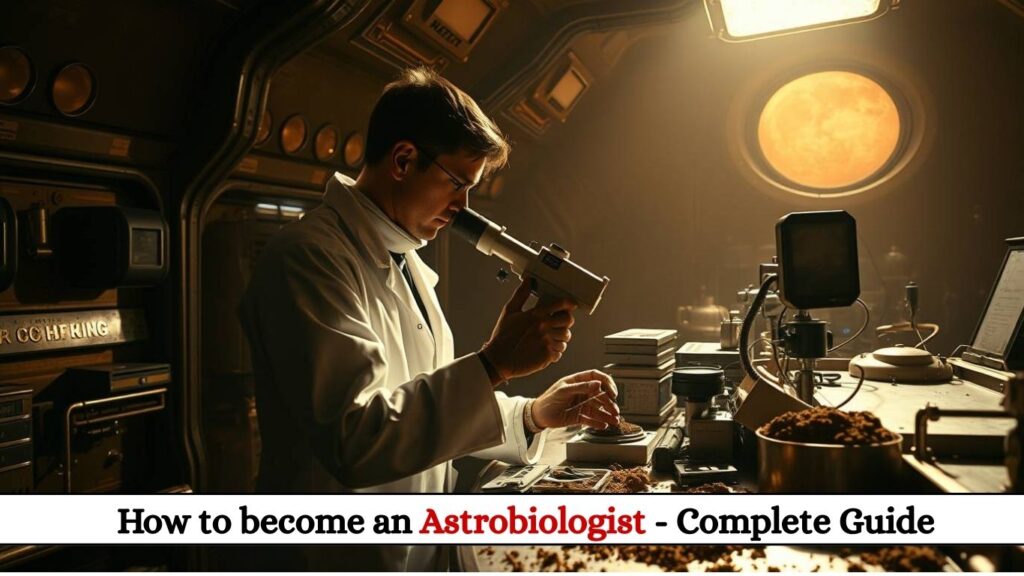
Introduction: The Search for Extraterrestrial Life
Astrobiologists stand at the thrilling intersection of biology, astronomy, and planetary science, asking one of humanity’s most profound questions: Are we alone in the universe? This multidisciplinary field combines cutting-edge research with space exploration to study life’s origins, evolution, and potential existence beyond Earth.
In this comprehensive guide, we’ll explore:
- The history and evolution of astrobiology
- Current salary ranges and career paths
- Key roles and specializations
- Essential qualifications and skills
- Step-by-step career roadmap
- Future breakthroughs on the horizon
- Top institutions and employers
Whether you’re a student fascinated by extremophiles or a researcher considering a career pivot, this guide illuminates your path to becoming a professional life-hunter in the cosmos.
History of Astrobiology
Early Speculation (Antiquity-1800s)
- 4th Century BCE: Aristotle proposes “spontaneous generation” theory
- 1600s: Christiaan Huygens speculates about extraterrestrial life in Cosmotheoros
- 1877: Giovanni Schiaparelli’s “canali” observations spark Mars life debates
Modern Foundations (1900-1990s)
- 1953: Miller-Urey experiment demonstrates abiotic amino acid formation
- 1976: Viking landers conduct first life-detection experiments on Mars
- 1996: ALH84001 meteorite controversy reignites Mars fossil discussions
Institutionalization (2000s-Present)
- 2001: NASA establishes Astrobiology Institute
- 2015: Discovery of liquid water on modern Mars
- 2023: James Webb Telescope detects potential biosignatures on exoplanets
Astrobiologist Salaries (2024)
| Position | Entry-Level | Mid-Career | Senior-Level |
|---|---|---|---|
| Research Associate | $55,000 | $75,000 | $95,000+ |
| Field Astrobiologist | $65,000 | $90,000 | $120,000+ |
| Mission Scientist | $85,000 | $120,000 | $160,000+ |
| Professor (Tenured) | $70,000 | $110,000 | $150,000+ |
Sector Variations:
- Academic: Lower base but grant opportunities
- Government (NASA/ESA): Strong benefits + mission access
- Private Sector (Blue Origin/SpaceX): Higher pay but fewer pure research roles
Roles & Specializations
1. Exoplanet Researchers
- Analyze JWST atmospheric spectra
- Model habitable zones
- Identify biosignature candidates
2. Extremophile Experts
- Study life in:
- Antarctic dry valleys
- Deep-sea vents
- Atacama Desert
- Test planetary analog sites
3. Instrument Developers
- Design life-detection tools
- Optimize spectrometers
- Create contamination protocols
4. Prebiotic Chemists
- Simulate early Earth conditions
- Study ribosome origins
- Experiment with alternative biochemistries
5. Mission Scientists
- Plan Mars/Enceladus sampling
- Select landing sites
- Interpret returned data
Essential Qualifications
Educational Pathways
- Undergraduate: Biology/Chemistry/Physics/Astronomy
- Graduate: Astrobiology-specific programs at:
- University of Washington
- ETH Zurich
- University of Edinburgh
- Postdoc: NASA NAI or ESA research fellowships
Key Technical Skills
✔ Spectroscopy interpretation
✔ Molecular biology techniques
✔ Planetary geology fundamentals
✔ Statistical modeling of rare events
✔ Field sampling protocols
Critical Soft Skills
- Creative interdisciplinary thinking
- Grant writing proficiency
- Public communication abilities
- Team science collaboration
5-Step Career Roadmap
1. Build Your Foundation (Years 1-4)
- Major in relevant STEM field
- Conduct undergraduate research
- Attend astrobiology conferences
2. Specialize (Years 5-8)
- Pursue PhD with astrobiology focus
- Publish in Astrobiology or Icarus
- Complete NASA Space Grant
3. Gain Field Experience (Years 9-12)
- Postdoc at research institution
- Antarctic/Mars analog fieldwork
- Contribute to mission teams
4. Establish Expertise (Years 13-20)
- Lead research groups
- Serve on decadal survey committees
- Advise space agencies
5. Shape the Field (20+ Years)
- Direct research centers
- Develop flagship missions
- Mentor next generation
Future Breakthrough Areas
2025-2030 Horizon
- Mars Sample Return analysis
- Europa Clipper subsurface data
- Venus Life Finder mission results
Emerging Specializations
🧫 Quantum Biology in space environments
🛰️ AI-Assisted Biosignature Detection
🧪 Synthetic Life for Space Adaptation
Institutions Leading the Search
- NASA Astrobiology Institute (USA)
- European Astrobiology Network (EU)
- Tokyo Tech Origins Research (Japan)
- Australian Centre for Astrobiology
- SETI Institute
Conclusion: Your Mission Awaits
Astrobiology offers unparalleled opportunities to answer fundamental questions about life’s cosmic context. With 30+ active exoplanet missions and 5 astrobiology-focused spacecraft in development, the field is entering its golden age.
Key Takeaways:
- Develop both depth and interdisciplinary breadth
- Gain hands-on experience with analogs and instruments
- Cultivate persistence – major discoveries may take decades
- Communicate your science to sustain public support
As we stand on the verge of potentially discovering extraterrestrial life, your work could literally redefine humanity’s place in the universe.
This guide combines scientific rigor, career strategy, and to help aspiring astrobiologists navigate this extraordinary field. Would you like me to emphasize any particular aspect of astrobiology careers? 🔍🪐













Post Comment